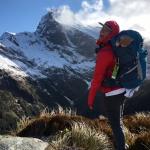Support
Wow! New Zealand was an absolute blast! If you’re reading this trying to get inspiration to study abroad or for your own enrichment grant proposal, I hope it gives you some. As a geo major and outdoor studies minor, I hoped to utilize my time in New Zealand to apply my academic disciplines to my personal hobbies in an entirely different place. While I found myself on many hikes and backpacking trips during my time in New Zealand, I had one particular trek on my bucket list – The Milford Track.
If you’ve done a little reading about outdoor opportunities in New Zealand, you may have noticed that ample exist. From backpacking to climbing to mountain biking to kayaking to surfing, it’s all world class. You also may have noticed that they have a designation for several tracks known as the “Great Walks.” These tracks receive this designation for their intense beauty and, as a consequence, overwhelming use. For this reason, New Zealand’s Department of Conservation (DOC) heavily regulates the Great Walks. During the summer season, known as the “Great Walks Season,” the DOC caps the number of users on the track per day in order to mitigate issues that accompany heavy use. During the winter season, many of the tracks close due to avalanche concerns; however, you may find yourself lucky enough to catch an open window where the track becomes hikeable. Some changes occur during this time, namely that avalanche danger increases, poor conditions exist on the track, the cost of the trek greatly decreases, and far fewer people – if any – may be on the trek with you.
I decided to hike the Milford Track, the most famous Great Walk, at the end of the winter season in the company of my long time best friend, Emma, who attends Bates College. Throughout the course of the trip, we discussed some of the differences we noticed regarding the DOC’s approach to recreation and how it may impact accessibility as well as Leave No Trace practices. The DOC requires hikers to sleep in huts placed along the track, rather than allowing freedom/dispersed camping or camping at designated campsites. Some tracks across the country DO have designated campsites, but many (even the less trafficked tracks) have huts placed along them.
Requiring recreators to utilize these accommodations forces those traveling the tracks to make specific plans, adapting their daily mileage to fit the dispersion of the huts. While many of the fees for hut usage remain low, to trek a Great Walk during the summer season will cost foreign travelers over $100 NZD a night, a primary example of the heavily debated topic regarding financial accessibility to outdoor opportunities. That being said, the high cost of hut usage on Great Walks provides the DOC with the funds to maintain these tracks, as well as decreases traffic, encouraging recreators to turn to less used, less expensive options. Furthermore, while the construction of the huts themselves certainly makes a mark on the landscape, they reduce overall impact by confining human impact to a very small space. Topics such as these relate strongly to the outdoor studies minor offered at SLU, which stresses a multi-disciplinary approach to outdoor recreation.
The differences in New Zealand’s approaches to conservation struck me almost immediately and may be one of the reasons why they have a reputation for maintaining their pristine wild spaces. The variety of geologic features expressed along the course of the trip allowed me the opportunity to imagine what the geologic past may have been like on New Zealand’s South Island, but I’ll spare you details. The opportunity to travel the Milford Track, affectionately known as “the finest walk in the world,” profoundly broadened my perspective, a great privilege and one that I’ll never forget.
